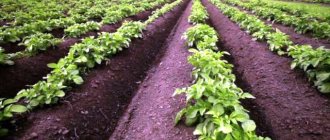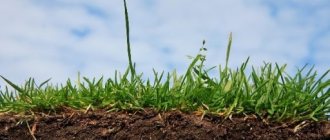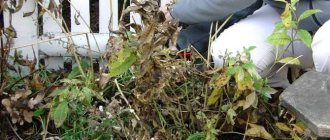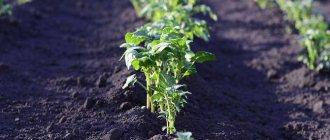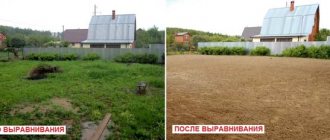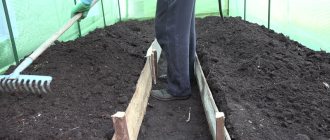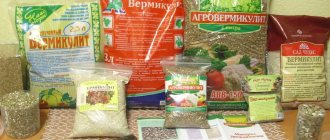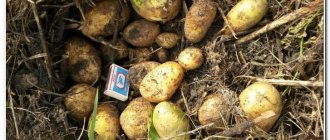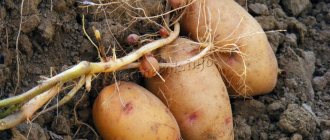Selecting a site for planting
Potatoes can be grown successfully in many soils suitable for the plant. More important are the illumination of the designated area and sufficient humidity. Exceeding the norm of the latter has an extremely negative effect on plant development. The likelihood of fungal and bacterial diseases, including late blight, also increases. Potato is a light-loving crop. Insufficient light leads to stretching of the tops, rapid yellowing of leaves and weak flowering. The result is small tubers and a very modest harvest.
How to till the soil
Autumn processing is carried out as follows:
| Plowing the site Suitable if the field is large and processing it manually is problematic. There are no special requirements - the depth is 25 cm, it is advisable to remove the roots of weeds if they come across. After plowing, there is no need to break up clods of earth . They will collapse on their own during the winter, but at the same time the soil will be saturated with oxygen and acquire a looser structure. | |
| Digging Carried out to the depth of a spade bayonet. Suitable for small beds. During the digging process, remove all roots of weeds, especially wheatgrass. |
Selecting the right crop rotation
It is better to plant potatoes in virgin soil. But in practice, you have to change garden crops or plant it in the same place. Due to the presence of common pests with nightshades (tomatoes, eggplants, peppers), it is not recommended to plant potatoes after them. Areas where cabbage used to grow are also not suitable. The reason is that a lot of lime is used to combat its diseases, which increases the likelihood of potato scabs. It is allowed to alternate planting potatoes with beets, zucchini, onions, cucumbers, beans and peas. You can return to your old place after 3 or 4 years.
Autumn processing
Preparing the soil for potatoes occurs after harvesting. Produced before the first frost. The procedure includes several main steps.
- The choice of site, which depends on its location and soil quality. Potatoes require sufficient sunlight to grow fully. No drafts and loose, well-aerated fertile soil.
- Activities that serve to resolve issues of how to fully prepare the soil for potatoes in the fall. Treat the soil against late blight, saturate it with moisture and nutrients.
Digging of the selected area is carried out using the bayonet of a shovel. Deep loosening should be accompanied by careful removal of wheatgrass rhizomes and other weeds. Preparing land for potatoes in the fall requires the addition of mineral salts in combination with rotted manure. The optimal autumn feeding is a mixture of 7 kg of organic matter with 15-17 g of potassium sulfate. Add another 35-40 g of superphosphate per 1 square meter. m area.
Advertisements
Bordeaux mixture is effective for treating late blight in the fall. The composition includes copper sulfate and quicklime.
Treating plots of land with copper sulfate is the most effective way to combat fungal diseases of nightshade crops. Preparing the soil for potatoes comes down to spilling a 1-3% solution of the drug at the rate of 10 liters of liquid per 1 square meter. m. After drying, dig up. Perform this procedure no more than once every 5 years, so as not to “poison” the ridges.
When do potatoes need organic matter?
Organic fertilizers are more beneficial for soil. They improve its composition and increase friability. The soil recovers faster when organic matter is added. The most popular organic fertilizers are:
- cattle manure - mullein;
- chicken manure, which contains the highest nitrogen and potassium content;
- green manure plants that are introduced into the soil for digging.
Ash and bone meal are also useful, but they must be added in large quantities, which are not always available. For example, you need 5 kg of ash per hectare of land . To get 5 kg you need to burn 110 kg of rye straw . And this is for one hundred square meters. Considering that rye straw is deficient, it will be difficult to provide sufficient nutrients.
Mullein
Mullein is the most accessible of all organic substances. It can be applied for digging when preparing the soil for potatoes in the fall, so that soil microorganisms process the substance by spring. Another way is to make compost. To do this you need:
- organize a place where the compost will ripen - a burst, pit or container;
- layer manure, soil, food waste from the kitchen, ash, chalk, weeds;
- to speed up ripening, you can add liquid containing beneficial bacteria - Baikal;
- wait 8 – 9 months .
Manure can be mixed with compost
Fertilizers for potatoes - which is better
Timely fertilizing helps to increase the yield three times. During the growing season, tubers tolerate huge amounts of nitrogen, potassium and phosphorus fertilizers. Preparing the soil for potatoes begins with the autumn application of potassium-phosphorus mixtures.
Nitrogen may not be used in the fall, since it is a very mobile fertilizer and is quickly washed into the lower layers of the soil. Phosphorus and potassium, on the contrary, remain in the soil for a long time because they do not have mobility. By spring they turn into an easily accessible form.
Video: Expert about autumn tillage
Potassium and phosphorus are available in the form of mineral and organic fertilizers. Which one to choose is a personal matter for each gardener. You can make complex mixtures that contain both mineral and organic additives.
To plant potatoes you can use:
- potassium sulfate at the rate of 2 kg per hundred square meters of land ;
- superphosphate - double or regular - 1 kg per hundred square meters ;
- stove ash obtained by burning wood or branches;
- compost based on mullein or chicken manure;
- In spring, complex mineral mixtures containing nitrogen are used.
If the soil is acidic
What kind of soil is needed for potatoes? Not too acidic and not too alkaline, that is, in the pH range of 5 to 6 . You can determine acidity using simple ancient methods:
- By the presence of weeds. If dandelion, coltsfoot, grows on the plot, then you can plant potatoes - the harvest will be good.
- Brew the bird cherry leaves. Throw a lump of earth from the intended planting site into the infusion. If the solution turns red, the soil reaction is acidic. If the solution is green - alkaline, blue - the reaction is neutral.
Video: List of fertilizers that need to be applied to the soil in the fall
If there is a need to reduce acidity, then preparing the soil for planting potatoes should begin with the addition of dolomite flour, lime or ash. These substances can be used in compost. The result will be better.
Soil quality improvement technology
To improve the quality of soil, a wide variety of methods and substances are used. Four main soil parameters can be improved: the number of earthworms, pH values, drainage and nutrient content.
| Soil quality indicators | Improvement technology |
| pH level | Improving overly acidic soil with a pH of 4.5-5.5 involves adding calcium carbonate, bone meal or peat ash. Alkaline soil with a pH greater than 7 requires oxidation by adding peat or manure. Neutral soils require standard fertilizing |
| Drainage and aeration | Heavy soil needs aeration and improved drainage, while light sandy soil needs structural improvement and increased moisture retention. For this purpose, compost, construction sand, perlite, vermiculite and water-retaining polymer crystals are used. |
| Fertility indicators; earthworms | The application of basic fertilizers helps to increase the nutritional value of the soil, and also makes the soil attractive to earthworms, which absorb organic waste and convert it into humus useful for plants. |
Fertilizers
The system for improving the soil through the application of fertilizers depends on the condition of the soil on the site. Heavy clay, peat, acidic and sandy soils, as well as solonetzes, require improvement. For heavy clay composition, organic fertilizers based on straw humus, peat, construction sand, composts and turf soil are recommended. Good results are achieved by regular application of lightening and loosening components, as well as ash, lime and manure.
Sandy soil is improved by adding straw humus and peat, and organic fertilizers and quick-acting mineral fertilizers should be applied more often.
Peat-bog soil is enriched and improved with manure, slurry, compost, sawdust and microbiological preparations. Fertilizers with a high content of phosphorus and potassium available to plants are also applied. To improve the soil structure, sand, compost and clay flour are added.
Sandy loam soils require regular enrichment with peat and compost, and mineral fertilizers are recommended to be applied in small doses, but quite often.
It is recommended to fertilize medium and loamy soils with organic matter, including the application of manure or compost for autumn tillage of the site. Organic and mineral fertilizers are applied as needed.
Green manure
Green manures are plants that are grown before planting the main crop and help enrich the soil with useful elements. The use of green manure plants is the best and most economical way to enrich the soil on a personal plot. The most beneficial plant in each specific case should be selected based on the nature of its effect.
| green manure plant | Impact on the ground |
| Legumes | Nitrogen saturation |
| Cruciferous cereals | Nitrogen saturation, prevention of mineralization |
| Legumes cruciferous asteraceae | Soil protection from erosion and weeds |
| Rapeseed and rapeseed | Increasing organic matter |
| Bean mustard | Removal of phosphates not absorbed by plants |
| Oilseed radish | Preventing mineral loss |
| Cruciferous legumes | Improving structure, loosening |
| Legumes Asteraceae | Increasing nematode resistance |
Disinfection
Disinfecting soil in open ground conditions is quite difficult for a number of reasons, the main ones being the labor intensity and high cost of such an event. However, there are several methods that allow you to disinfect the land yourself and with minimal time and money.
| Name | Product type | Usage |
| Bleaching powder | Chemical | Six months before planting tubers, sprinkle 100–200 g of the drug per square meter |
| Formalin | Chemical | A month before planting tubers, dissolve 250 ml of a 40% solution of the product in 10 liters of water to treat each square meter of soil |
| TMTD | Chemical | Immediately before planting the tubers, add 10 liters of solution per square meter |
| "Iprodion" | Chemical | Add to the holes when planting tubers at the rate of 40-60 g per square meter |
| "Fitosporin" | Biological | When preparing the soil in spring or autumn, add 6 ml per 10 liters of water per square meter |
| "Trichodermin" | Biological | Before planting tubers, add 5 g per 5 liters of soil |
| "Glyokladin" | Biological | Application to a depth of at least 1 cm when planting tubers |
| "Alirin-B" | Biological | Preventive spillage of soil on the site at the rate of 5 liters of solution per square meter |
| "Gamair" | Biological | Preventive spillage of soil on the site at the rate of 5 liters of solution per square meter |
Potatoes are a demanding crop in terms of placement on the site after other plants. It is advisable to plant it after crops used for green manure. Perennial grasses and legumes are considered a very good predecessor. However, after such plants, the risk of damage to the vegetable crop by wireworm increases. In vegetable crop rotations, potatoes should be cultivated after cabbage, cucumbers, onions and corn.
